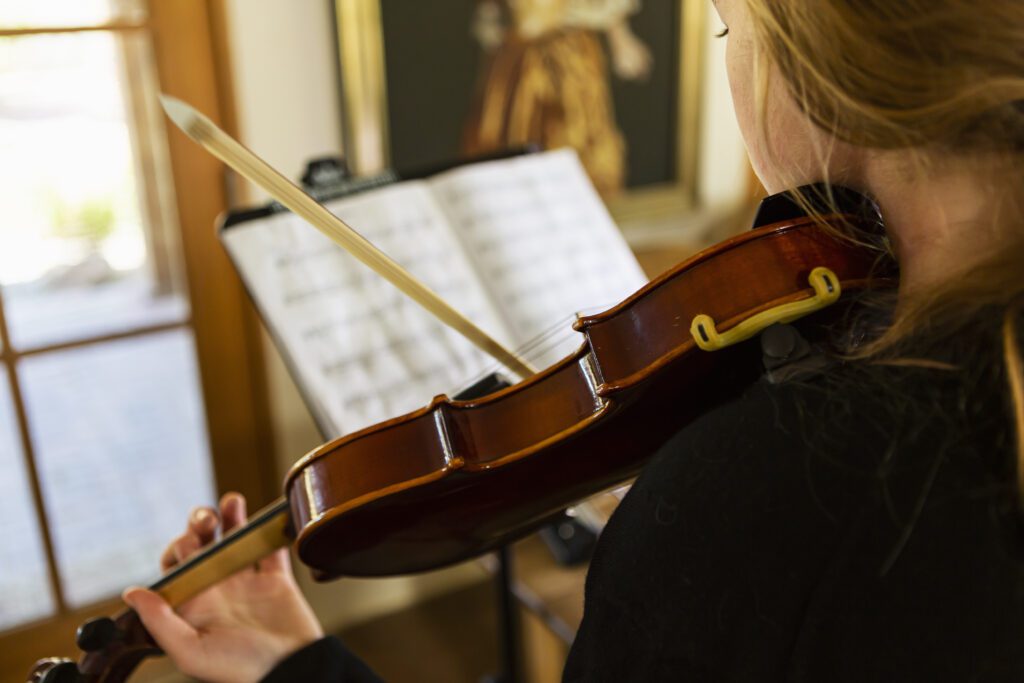Is 2 Hours of Violin Practice a Day Enough? | Optimal Violin Practice Routine
Mastering the violin requires more than just time—it demands focus, structure, and passion. One of the most common questions among aspiring violinists is: Is two hours of practice a day enough? The answer depends on your skill level, goals, and how effectively you use those two hours. In this blog, we’ll explore how to optimize your practice time, address common pitfalls, and offer tips tailored to beginners, intermediates, and advanced players by focusing on the optimal violin practice routine.
The Foundation of an Optimal Violin Practice Routine

Time is just one factor in progress. What truly matters is the quality of practice. Aimless repetition won’t help; structured and intentional practice is the key to mastering this intricate instrument. It ensures that each minute spent is productive and helps you progress.
To make your practice time as effective as possible, it’s crucial to break it into focused segments that address different aspects of your playing. A well-balanced practice routine will give you steady improvement over time.
Visual Guide to a Two-Hour Practice Schedule
To help you understand how to structure your two-hour practice, here’s a simple breakdown of a two hours practice routine:
| Time | Focus Area | Details |
|---|---|---|
| 10 minutes | Warm-Up | Scales, arpeggios, and light finger exercises. |
| 30 minutes | Technique | Bowing exercises, vibrato, intonation, shifting drills. |
| 50 minutes | Repertoire Practice | Work on pieces or etudes, focusing on challenging sections. |
| 20 minutes | Musicality and Expression | Dynamics, phrasing, and tone refinement. |
| 10 minutes | Cool-Down and Reflection | Play through a favorite piece or review progress. |
By following this routine, you can ensure that every area of your playing is given the attention it needs.
What Makes a Structured Violin Practice Routine Effective?

A structured violin practice routine focuses on specific, measurable goals. Here’s what makes it work:
- Targeted Goals: Each session should focus on one specific skill, like bowing, shifting, or vibrato. This helps you improve gradually and effectively.
- Consistency: Daily practice is key. The more regularly you follow your optimal violin practice routine, the quicker you’ll see improvement.
- Reflection: Periodically assess your practice to ensure that you’re meeting your goals and adjusting as necessary. An optimal violin practice routine should evolve as your skills progress.
Common Pitfalls and How to Avoid Them
Even with a structured practice routine, some mistakes can hinder your progress. Here’s what to watch out for:
Over-Practicing Without Breaks:
- Solution: Take short breaks every 30–40 minutes to prevent mental and physical fatigue, which can reduce the effectiveness of your optimal violin practice routine.
Ignoring Posture:
- Solution: Pay close attention to your posture and hand positioning. Correct posture ensures that your optimal violin practice routine doesn’t cause injury.
Rushing Through Exercises:
- Solution: Slow down during difficult sections. Prioritize accuracy over speed for the best results within your optimal violin practice routine.
Skipping Warm-Ups or Cool-Downs:
- Solution: Always begin and end with warm-up and cool-down exercises. They set you up for success and contribute to a balanced optimal violin practice routine.
Tailoring Your Violin Practice Routine to Your Skill Level

For Beginners
Two hours of practice may feel daunting for beginners. It’s better to start with shorter sessions and build up. A 30–60-minute practice time, focused on basic techniques, is often enough at this stage.
Key Components of an Optimal Violin Practice Routine for Beginners:
- Focus on the fundamentals: bow hold, posture, and finger placement.
- Practice simple scales and pieces.
- Set small, achievable goals like learning a new scale or mastering a simple song.
For Intermediate Players
Intermediate violinists are in the perfect spot to benefit from a two-hour practice session. Now is the time to refine your technique and deepen your understanding of more complex pieces. Your optimal violin practice routine should include working on more advanced scales, challenging pieces, and building musicality.
Key Components of an Optimal Violin Practice Routine for Intermediate Players:
- Expand your repertoire by tackling more difficult pieces.
- Focus on improving vibrato and bow control.
- Start incorporating dynamics and phrasing into your performance.
For Advanced Players
For advanced violinists, two hours may seem like a short time to practice, but a focused and strategic practice routine can still make a significant impact. Advanced players should focus on mastering difficult techniques and fine-tuning musical expression.
Key Components of an Optimal Violin Practice Routine for Advanced Players:
- Focus on high-level repertoire such as concertos or virtuosic solos.
- Break down the most difficult passages and work on them slowly.
- Record your practice sessions to review and fine-tune your technique.
Maximizing Efficiency in Your Optimal Violin Practice Routine

To make the most out of your violin practice routine, consider these tips:
- Record Your Practice: Listening to recordings helps identify areas that need attention.
- Use Timers: Allocate set periods for each section of your practice, ensuring no area is neglected in your optimal violin practice routine.
- Leverage Technology: Use apps like Tunable or TonalEnergy for real-time feedback on intonation and rhythm.
- Stay Inspired: Watch professional violin performances and stay connected to a community for motivation and fresh ideas.
Incorporating these strategies into your optimal violin practice routine will ensure maximum productivity and enjoyment.
Beyond the Practice Room: Explore New Horizons
While your optimal violin practice routine is crucial, there’s more to growing as a violinist. Here’s how you can complement your practice:
- Join an Ensemble: Playing with others will improve your timing and rhythm.
- Participate in Competitions: Challenge yourself and get valuable feedback.
- Attend Live Performances: Learn from watching experts and get inspired to push your limits.
Final Thoughts: Is Two Hours Enough?
Two hours of violin practice a day is enough—if done intentionally. For beginners, shorter sessions may suffice, while intermediate and advanced players can use this time to refine technique, explore repertoire, and express musicality. The key lies in consistency, structure, and passion.
Your Next Step to Success
Ready to Hone your violin skills? The Mystic Keys offers online violin courses designed to fit your schedule and goals. Learn from expert instructors and join a global community of passionate musicians.
📢 Explore More at The Mystic Keys Homepage
🎻 Enroll in Our Online Violin Classes
For more music content and exciting offers follow us on Facebook, Instagram, YouTube, LinkedIn, Twitter, Pinterest, Reddit, Threads, and Quora.








